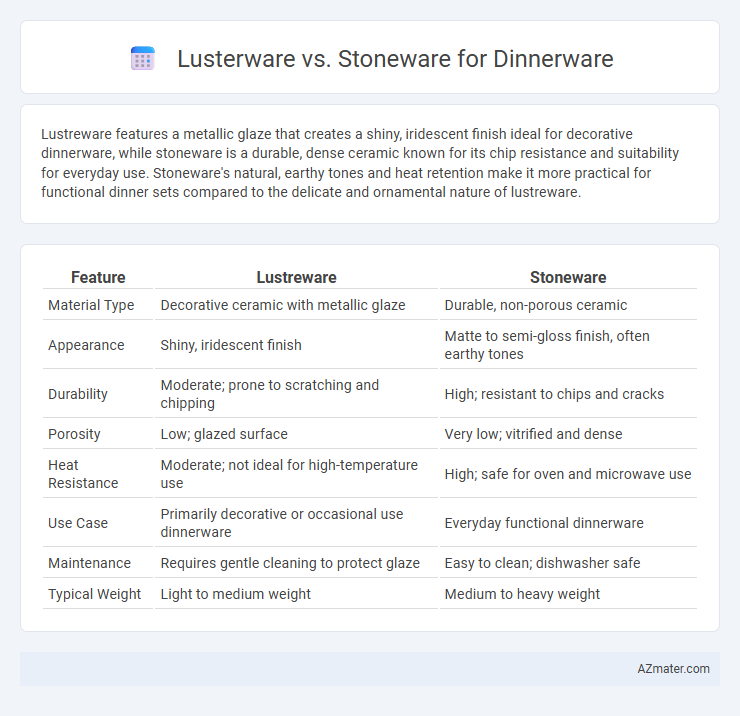Lustreware features a metallic glaze that creates a shiny, iridescent finish ideal for decorative dinnerware, while stoneware is a durable, dense ceramic known for its chip resistance and suitability for everyday use. Stoneware's natural, earthy tones and heat retention make it more practical for functional dinner sets compared to the delicate and ornamental nature of lustreware.
Table of Comparison
| Feature | Lustreware | Stoneware |
|---|---|---|
| Material Type | Decorative ceramic with metallic glaze | Durable, non-porous ceramic |
| Appearance | Shiny, iridescent finish | Matte to semi-gloss finish, often earthy tones |
| Durability | Moderate; prone to scratching and chipping | High; resistant to chips and cracks |
| Porosity | Low; glazed surface | Very low; vitrified and dense |
| Heat Resistance | Moderate; not ideal for high-temperature use | High; safe for oven and microwave use |
| Use Case | Primarily decorative or occasional use dinnerware | Everyday functional dinnerware |
| Maintenance | Requires gentle cleaning to protect glaze | Easy to clean; dishwasher safe |
| Typical Weight | Light to medium weight | Medium to heavy weight |
Introduction to Lustreware and Stoneware
Lustreware features a distinctive iridescent metallic glaze applied over ceramic, creating a shimmering, reflective surface prized for decorative and elegant dinnerware. Stoneware is a durable, dense ceramic fired at high temperatures, known for its chip-resistant and heat-retentive qualities, making it highly functional for everyday use. Both materials offer unique aesthetics and performance characteristics essential for selecting the ideal dinnerware style.
Historical Background of Lustreware and Stoneware
Lustreware originated in the Middle East during the 9th century, characterized by its iridescent metallic glaze achieved through a complex firing process. Stoneware, dating back to ancient China and widely produced in Europe since the 17th century, is a durable, non-porous ceramic made from refined clay and fired at high temperatures. The historical significance of lustreware lies in its artistic and decorative appeal, while stoneware is valued for its practicality and strength in everyday kitchen use.
Manufacturing Processes Compared
Lustreware dinnerware is created by applying a metallic glaze that undergoes a firing process to produce an iridescent finish, typically involving multiple firings and precise temperature control. Stoneware is made from dense clay fired at high temperatures between 1,100degC and 1,300degC, resulting in a durable, non-porous ceramic that is often glazed once. The manufacturing of lustreware requires more intricate glazing techniques and increased labor, while stoneware emphasizes robustness through its firing temperature and clay composition.
Visual Appeal: Shine vs. Simplicity
Lustreware dinnerware captivates with its iridescent, glossy finish that reflects light, creating a vibrant and eye-catching shine perfect for elegant table settings. Stoneware offers a more subdued, matte surface emphasizing natural textures and earthy tones, appealing to those who prefer understated simplicity and rustic charm. Choosing between the two depends on whether a dinnerware set should be a focal point through its luminous sheen or harmonize subtly with minimalistic decor.
Durability and Everyday Usability
Lustreware features a distinctive metallic glaze that offers moderate durability but tends to be more prone to chipping and surface wear compared to stoneware. Stoneware is fired at higher temperatures, resulting in a dense, non-porous material renowned for exceptional strength and resistance to daily impact, making it ideal for everyday dinnerware. The robust composition of stoneware ensures it withstands frequent use, dishwasher cycles, and microwave heating, whereas lustreware requires more delicate handling to maintain its decorative finish.
Maintenance and Care Requirements
Lustreware requires gentle hand washing with mild detergents to preserve its metallic glaze, avoiding abrasive scrubbers that can damage the finish. Stoneware is more durable and often dishwasher safe, but it still benefits from avoiding sudden temperature changes to prevent cracking. Proper storage and cautious handling prolong the lifespan of both materials while maintaining their aesthetic appeal.
Price and Accessibility Differences
Lustreware dinnerware typically commands higher prices due to its intricate metallic glaze and artisanal production methods, making it less accessible to budget-conscious consumers. Stoneware offers a more affordable and widely available option, produced in larger quantities with durable materials suitable for everyday use. The price gap between lustreware and stoneware reflects differences in manufacturing complexity and market availability, influencing consumer choice based on budget and intended use.
Suitability for Formal vs. Casual Dining
Lustreware exudes a glossy, iridescent finish ideal for formal dining occasions due to its elegant and decorative appearance. Stoneware offers a more rustic, matte texture that enhances casual dining settings with its durability and relaxed aesthetic. Selecting between the two depends on the desired ambiance: lustreware elevates sophisticated dinner parties, while stoneware caters to everyday, informal meals.
Environmental Impact and Sustainability
Lustreware often involves metallic glazes that require energy-intensive firing processes, potentially increasing its environmental footprint compared to stoneware. Stoneware, made from natural clay and fired at high temperatures, tends to be more durable and eco-friendly, promoting sustainability through longer-lasting use and minimal chemical additives. Choosing stoneware for dinnerware supports reduced waste and lower energy consumption, aligning better with environmental sustainability goals.
Which is Right for Your Table: Final Considerations
Lustreware offers a glossy, metallic sheen that elevates formal dining experiences, while stoneware provides durability and a rustic charm suited for everyday use. Consider your lifestyle: lustreware is more delicate and ideal for special occasions, whereas stoneware withstands frequent dishwasher and microwave use. Selecting between them depends on balancing aesthetic preferences with practical needs for your table setting.

Infographic: Lustreware vs Stoneware for Dinnerware
 azmater.com
azmater.com